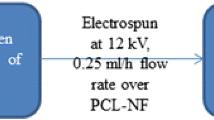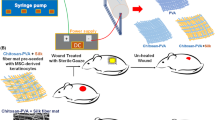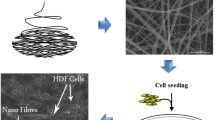Abstract
The electrospinning technique allows engineering biomimetic scaffolds within micro to nanoscale range mimicking natural extracellular matrix (ECM). Chitosan (CS) and polycaprolactone (PCL) were dissolved in a modified solvent mixture consisting of formic acid and acetone (3:7) and mixed in different weight ratios to get chitosan-polycaprolactone [CS-PCL] blend solutions. The CS-PCL blend polymer was electrospun in the same solvent system and compared with PCL. The physicochemical characterization of the electrospun fibrous mats was done using scanning electron microscopy (SEM), Fourier transform infrared spectroscopy (FTIR), tensile test, swelling properties, water contact angle (WCA) analysis, surface profilometry and thermo gravimetric analysis (TGA). The CS-PCL fibrous mat showed decreased hydrophobicity. The CS-PCL mats also showed improved swelling property, tensile strength, thermal stability and surface roughness. The cytocompatibility of the CS-PCL and PCL fibrous mats were examined using mouse fibroblast (L-929) cell line by direct contact and cellular activity with extract of materials confirmed non-cytotoxic nature. The potential of CS-PCL and PCL fibrous mats as skin tissue engineering scaffolds were assessed by cell adhesion, viability, proliferation and actin distribution using human keratinocytes (HaCaT) and L-929 cell lines. Results indicate that CS-PCL is a better scaffold for attachment and proliferation of keratinocytes and is a potential material for skin tissue engineering.












Similar content being viewed by others
References
Kumbar SG, Nukavarapu SP, James R, Nair LS, Laurencin CT. Electrospun poly(lactic acid-co-glycolic acid) scaffolds for skin tissue engineering. Biomaterials. 2008;29(30):4100–7.
Martins A, Araujo JV, Reis RL, Neves NM. Electrospun nanostructured scaffolds for tissue engineering applications. Nanomedicine (Lond). 2007;2(6):929–42.
Blakeney BA, Tambralli A, Anderson JM, Andukuri A, Lim DJ, Dean DR, et al. Cell infiltration and growth in a low density, uncompressed three-dimensional electrospun nanofibrous scaffold. Biomaterials. 2011;32(6):1583–90.
Prabhakaran MP, Venugopal JR, Ramakrishna S. Mesenchymal stem cell differentiation to neuronal cells on electrospun nanofibrous substrates for nerve tissue engineering. Biomaterials. 2009;30(28):4996–5003.
Woei K, Hutmacher DW, Schantz JT, Seng C, Too HP, Chye T, et al. Evaluation of ultra-thin poly(epsilon-caprolactone) films for tissue-engineered skin. Tissue Eng. 2001;7(4):441–55.
Gupta D, Venugopal J, Prabhakaran MP, Dev VR, Low S, Choon AT, et al. Aligned and random nanofibrous substrate for the in vitro culture of Schwann cells for neural tissue engineering. Acta Biomater. 2009;5(7):2560–9.
Wang TJ, Wang IJ, Lu JN, Young TH. Novel chitosan-polycaprolactone blends as potential scaffold and carrier for corneal endothelial transplantation. Mol Vis. 2012;18:255–64.
Jayakumar R, Prabaharan M, Nair SV, Tamura H. Novel chitin and chitosan nanofibers in biomedical applications. Biotechnol Adv. 2010;28(1):142–50.
Zubareva A, Ily’ina A, Prokhorov A, Kurek D, Efremov M, Varlamov V, et al. Characterization of protein and peptide binding to nanogels formed by differently charged chitosan derivatives. Molecules. 2013;18(7):7848–64.
Adekogbe I, Ghanem A. Fabrication and characterization of DTBP-crosslinked chitosan scaffolds for skin tissue engineering. Biomaterials. 2005;26(35):7241–50.
Singh DK, Ray AR. Biomedical applications of chitin, chitosan, and their derivatives. J Macromol Sci Part C. 2000;40(1):69–83.
Sarasam A, Madihally SV. Characterization of chitosan-polycaprolactone blends for tissue engineering applications. Biomaterials. 2005;26(27):5500–8.
Wu L, Li H, Li S, Li X, Yuan X, Zhang Y. Composite fibrous membranes of PLGA and chitosan prepared by coelectrospinning and coaxial electrospinning. J Biomed Mater Res A. 2010;92(2):563–74.
Ohkawa K, Cha D, Kim H, Nishida A, Yamamoto H. Electrospinning of chitosan. Macromol Rapid Commun. 2004;25(18):1600–5.
Shalumon KT, Anulekha KH, Girish CM, Prasanth R, Nair SV, Jayakumar R. Single step electrospinning of chitosan/poly(caprolactone) nanofibers using formic acid/acetone solvent mixture. Carbohydr Polym. 2010;80(2):413–9.
Salgado AJ, Coutinho OP, Reis RL. Novel starch-based scaffolds for bone tissue engineering: cytotoxicity, cell culture, and protein expression. Tissue Eng. 2004;10(3–4):465–74.
Pham QP, Sharma U, Mikos AG. Electrospinning of polymeric nanofibers for tissue engineering applications: a review. Tissue Eng. 2006;12(5):1197–211.
Woodruff MA, Hutmacher DW. The return of a forgotten polymer—polycaprolactone in the 21st century. Prog Polym Sci. 2010;35(10):1217–56.
Zhong X, Ji C, Chan AL, Kazarian S, Ruys A, Dehghani F. Fabrication of chitosan/poly(ε-caprolactone) composite hydrogels for tissue engineering applications. J Mater Sci Mater Med. 2011;22(2):279–88.
Ratner BD, Hoffman AS, Schoen FJ, Lemons JE, editors. Biomaterials science: an introduction to materials in medicine. 3 ed. Engineered Natural Materials. Waltham: The Academic Press; 2013.
Dash M, Chiellini F, Ottenbrite RM, Chiellini E. Chitosan—a versatile semi-synthetic polymer in biomedical applications. Prog Polym Sci. 2011;36(8):981–1014.
Geng X, Kwon O-H, Jang J. Electrospinning of chitosan dissolved in concentrated acetic acid solution. Biomaterials. 2005;26(27):5427–32.
Sun K, Li ZH. Preparations, properties and applications of chitosan based nanofibers fabricated by electrospinning. Express Polym Lett. 2011;5(4):342–61.
Sangsanoh P, Supaphol P. Stability improvement of electrospun chitosan nanofibrous membranes in neutral or weak basic aqueous solutions. Biomacromolecules. 2006;7(10):2710–4.
Zargham S, Bazgir S, Tavakoli A, Rashidi AS, Damerchely R. The effect of flow rate on morphology and deposition area of electrospun nylon 6 nanofiber. J Eng Fibers Fabr. 2012;7(4):42–9.
Hsia HC, Nair MR, Mintz RC, Corbett SA. The fiber diameter of synthetic bioresorbable extracellular matrix influences human fibroblast morphology and fibronectin matrix assembly. Plast Reconstr Surg. 2011;127(6):2312–20.
Zhu X, Cui W, Li X, Jin Y. Electrospun fibrous mats with high porosity as potential scaffolds for skin tissue engineering. Biomacromolecules. 2008;9(7):1795–801.
Neves SC, Moreira Teixeira LS, Moroni L, Reis RL, Van Blitterswijk CA, Alves NM et al. Chitosan/poly(ε-caprolactone) blend scaffolds for cartilage repair. Biomaterials. 2011;32(4):1068–79.
Olivieri MP, Rittle KH, Tweden KS, Loomis RE. Comparative biophysical study of adsorbed calf serum, fetal bovine serum and mussel adhesive protein films. Biomaterials. 1992;13(4):201–8.
Liu H, Webster TJ. Nanomedicine for implants: a review of studies and necessary experimental tools. Biomaterials. 2007;28(2):354–69.
Affandi N, Truong Y, Kyratzis I, Padhye R, Arnold L. A non-destructive method for thickness measurement of thin electrospun membranes using white light profilometry. J Mater Sci. 2010;45(5):1411–8.
Hsin-I Chang, Wang Y. Cell responses to surface and architecture of tissue engineering scaffolds. In: Eberli D, editor. Regenerative medicine and tissue engineering—cells and biomaterials. INTECH; 2011.
Tao K, Bai XZ, Zhang ZF, Shi JH, Hu XL, Tang CW, et al. Construction of the tissue engineering seed cell (HaCaT-EGF) and analysis of its biological characteristics. Asian Pac J Trop Med. 2013;6(11):893–6.
Shalumon KT, Anulekha KH, Chennazhi KP, Tamura H, Nair SV, Jayakumar R. Fabrication of chitosan/poly(caprolactone) nanofibrous scaffold for bone and skin tissue engineering. Int J Biol Macromol. 2011;48(4):571–6.
Mei N, Chen G, Zhou P, Chen X, Shao ZZ, Pan LF, et al. Biocompatibility of Poly(epsilon-caprolactone) scaffold modified by chitosan—the fibroblasts proliferation in vitro. J Biomater Appl. 2005;19(4):323–39.
Jeong SI, Krebs MD, Bonino CA, Samorezov JE, Khan SA, Alsberg E. Electrospun chitosan-alginate nanofibers with in situ polyelectrolyte complexation for use as tissue engineering scaffolds. Tissue Eng Part A. 2011;17(1–2):59–70.
Chung TW, Wang YZ, Huang YY, Pan CI, Wang SS. Poly (ε-caprolactone) grafted with nano-structured chitosan enhances growth of human dermal fibroblasts. Artif Organs. 2006;30(1):35–41.
Tuzlakoglu K, Santos MI, Neves N, Reis RL. Design of nano- and microfiber combined scaffolds by electrospinning of collagen onto starch-based fiber meshes: a man-made equivalent of natural extracellular matrix. Tissue Eng Part A. 2011;17(3–4):463–73.
Pok SW, Wallace KN, Madihally SV. In vitro characterization of polycaprolactone matrices generated in aqueous media. Acta Biomater. 2010;6(3):1061–8.
Acknowledgments
The research work was supported by the DST Fast Track Grant (SR/FT/LS-128/2009, Government of India). The authors acknowledge the technical help from Mr. Arumugham V. and Ms. Leena Joseph, Calibration Cell for profilometry analysis and Ms. Geetha, Department of Tissue Engineering and Regenerative Technologies for contact angle measurements.
Author information
Authors and Affiliations
Corresponding author
Rights and permissions
About this article
Cite this article
Prasad, T., Shabeena, E.A., Vinod, D. et al. Characterization and in vitro evaluation of electrospun chitosan/polycaprolactone blend fibrous mat for skin tissue engineering. J Mater Sci: Mater Med 26, 28 (2015). https://doi.org/10.1007/s10856-014-5352-8
Received:
Accepted:
Published:
DOI: https://doi.org/10.1007/s10856-014-5352-8




